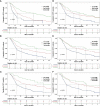Nomogram established on account of Lasso-Cox regression for predicting recurrence in patients with early-stage hepatocellular carcinoma
- PMID: 36505501
- PMCID: PMC9726717
- DOI: 10.3389/fimmu.2022.1019638
Nomogram established on account of Lasso-Cox regression for predicting recurrence in patients with early-stage hepatocellular carcinoma
Abstract
Purpose: To investigate the risk factors for recurrence in patients with early-stage hepatocellular carcinoma (HCC) after minimally invasive treatment with curative intent, then to construct a prediction model based on Lasso-Cox regression and visualize the model built.
Methods: Clinical data were collected from 547 patients that received minimally invasive treatment in our hospital from January 1, 2012, to December 31, 2016. Lasso regression was used to screen risk factors for recurrence. Then we established Cox proportional hazard regression model and random survival forest model including several parameters screened by Lasso regression. An optimal model was selected by comparing the values of C-index, then the model was visualized and the nomogram was finally plotted.
Results: The variables screened by Lasso regression including age, gender, cirrhosis, tumor number, tumor size, platelet-albumin-bilirubin index (PALBI), and viral load were incorporated in the Cox model and random survival forest model (P<0.05). The C-index of these two models in the training sets was 0.729 and 0.708, and was 0.726 and 0.700 in the validation sets, respectively. So we finally chose Lasso-Cox regression model, and the calibration curve in the validation set performed well, indicating that the model built has a better predictive ability. And then a nomogram was plotted based on the model chosen to visualize the results.
Conclusions: The present study established a nomogram for predicting recurrence in patients with early-stage HCC based on the Lasso-Cox regression model. This nomogram was of some guiding significance for screening populations at high risk of recurrence after treatment, by which doctors can formulate individualized follow-up strategies or treatment protocols according to the predicted risk of relapse for patients to improve the long-term prognosis.
Keywords: Lasso-Cox regression; hepatocellular carcinoma; nomogram; prediction; recurrence.
Copyright © 2022 Wang, Qiao, Zhang, Liu, Li, Zang, Mei, Zheng and Zhang.
Conflict of interest statement
The authors declare that the research was conducted in the absence of any commercial or financial relationships that could be construed as a potential conflict of interest.
Figures





References
-
- Wong JS, Wong GL, Tsoi KK, Ye R, Zhu Y, Zhou L, et al. . Meta-analysis: the efficacy of antiviral therapy in prevention of recurrence after curative treatment of chronic hepatitis b-related hepatocellular carcinoma. Aliment Pharmacol Ther (2011) 33:1104–12. doi: 10.1111/j.1365-2036.2011.04634.x - DOI - PubMed
MeSH terms
LinkOut - more resources
Full Text Sources
Medical

